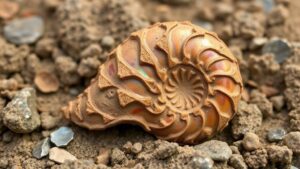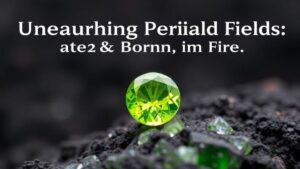The Mystery of Hollow Fossils: Unveiling Life Trapped in Ancient Mineral Casts
The Mystery of Hollow Fossils: Unveiling Life Trapped in Ancient Mineral Casts
Hollow fossils, often overlooked in the vast array of fossil types, offer a unique glimpse into the ancient biosphere. These remarkable remnants represent an intricate interplay between biological processes and geological changes over millions of years. For rockhounds and mineral collectors, understanding these fossils can enhance collecting strategies, scientific knowledge, and appreciation for Earth’s history.
What Are Hollow Fossils?
Hollow fossils are typically the mineralized remains of ancient organisms, characterized by a void or cavity where the original biological material has either decayed or been replaced by minerals. This phenomenon can occur in various types of fossils, including bones, shells, and even plant matter. The process of mineralization leads to the formation of casts, where minerals fill in the molds created by decaying organic substances, resulting in fascinating hollow structures.
Formation Processes
Understanding how hollow fossils form is crucial for collectors. The formation usually involves several key processes:
- Mineral Replacement: This occurs when an organism’s remains are buried rapidly in sediment. Over time, water rich in minerals infiltrates the remains, progressively replacing organic materials with minerals like silica, calcite, or pyrite.
- Permineralization: This method involves minerals depositing into the pores and cavities of organic tissue, preserving fine details of the organism.
- Articulated Remains: Hollow fossils also arise from articulated organisms whose soft parts decompose while the hard structures such as bones or shells remain intact, forming a hollow cast.
Historical Significance
Hollow fossils are valuable not only for their scientific intrigue but also for their ability to teach us about ancient environments. Studies of these fossils have revealed insights into the ecosystems of the past:
- The discovery of hollow dinosaur bones, for instance, has led paleontologists to understand the feeding habits and growth patterns of various species.
- Paleoecological studies use hollow mollusks to reconstruct marine environments and climate conditions from millions of years ago.
Scientific Data and Measurements
Researchers utilize specific scientific methodologies to study hollow fossils. Techniques such as CT scanning allow for a detailed three-dimensional analysis of fossils without damaging them. For example, a CT scan can reveal the internal structure of a hollow fossil, enabling scientists to estimate the organisms size, age, and even its pathologies.
Statistically, about 90% of vertebrate remains in fossil records display some form of hollow structure, indicating distinct evolutionary advantages such as weight reduction and thermal regulation. In some taxa, hollow bones contribute to flight efficiency amongst birds, a feature evolving over 150 million years ago.
Collecting Hollow Fossils
For rockhounds and mineral collectors, locating and identifying hollow fossils can be particularly rewarding. Here are practical tips for effective collecting:
- Research Locations: Start by determining potential fossil-rich sites, such as ancient marine sediments or riverbeds known for their geological richness.
- Use Appropriate Tools: Equip yourself with tools such as geological hammers, chisels, and brushes to safely extract and clean fossils. A magnifying glass will aid in identifying finer details.
- Observe Proper Techniques: Always adhere to ethical collecting practices, ensuring permission when on private lands and following local regulations.
Caring for Hollow Fossils
Once collected, maintaining the condition of hollow fossils is paramount:
- Storage: Store fossils in acid-free containers away from direct sunlight to prevent degradation.
- Handling: Always handle fossils with care to avoid breaking or chipping. Use gloves when necessary to prevent oils from your skin transferring to the fossil.
Future Research Directions
As technology advances, the future of hollow fossil research looks promising. Innovations such as 3D printing of hollow fossils will allow scientists to create physical models for study and education, bridging gaps in understanding ancient ecosystems.
Also, collaborative efforts between paleontologists and geologists will likely yield new discoveries about the significance of hollow structures in the evolutionary chain, providing insights into survival mechanisms of various species.
Actionable Takeaways
The exploration of hollow fossils opens doors to understanding Earth’s ancient life. For rockhounds and collectors, diving into this niche can enrich both personal collections and contribute to broader scientific endeavors. Here are key takeaway points:
- Familiarize with historical contexts and formation processes of hollow fossils.
- Use modern technologies for better identification and analysis of collected specimens.
- Practice ethical collection and dedicated preservation methods to protect these invaluable geological treasures.



